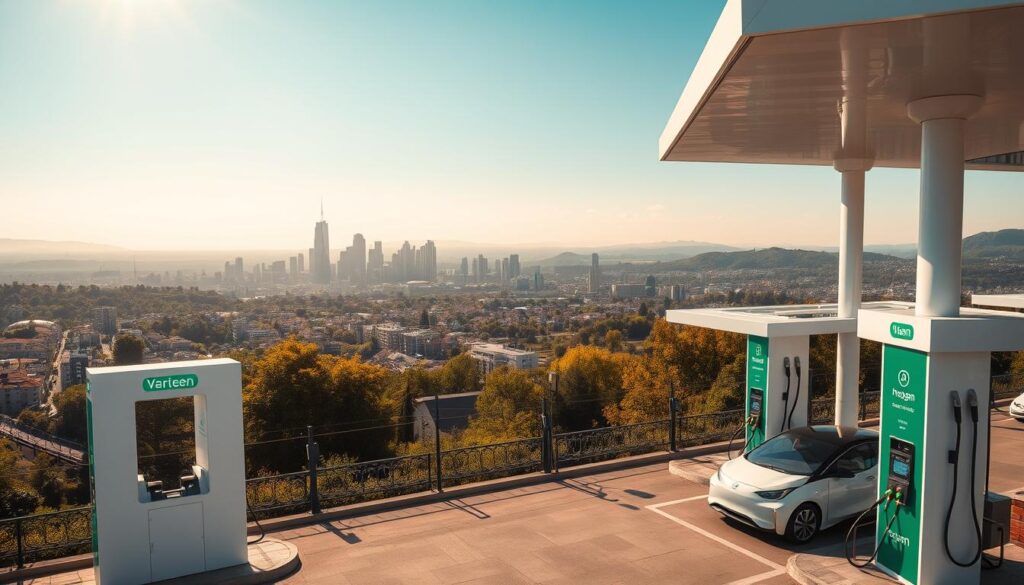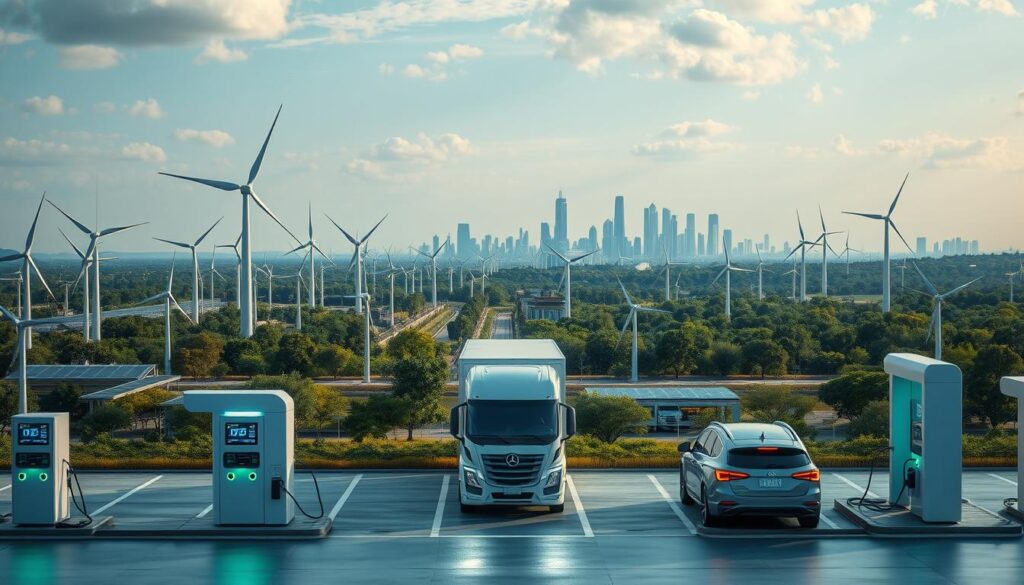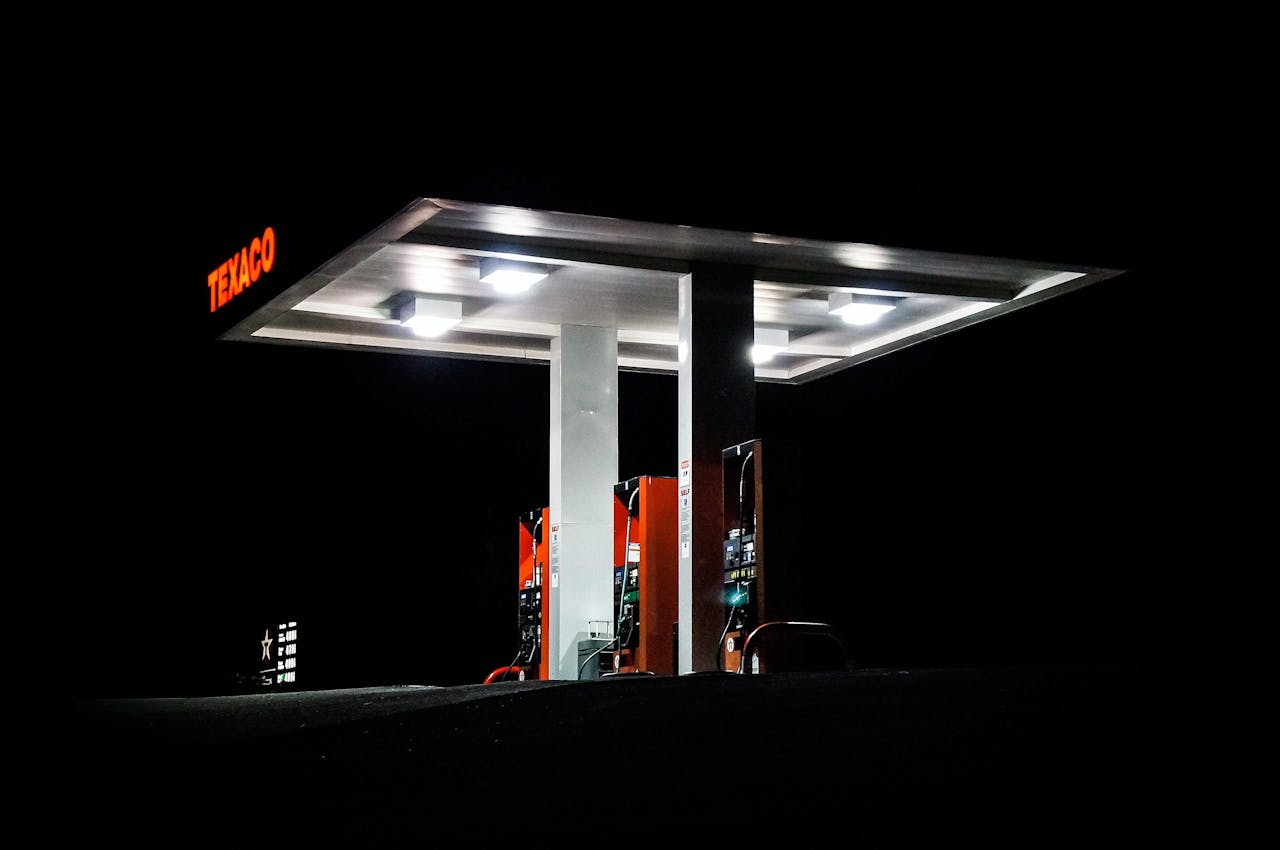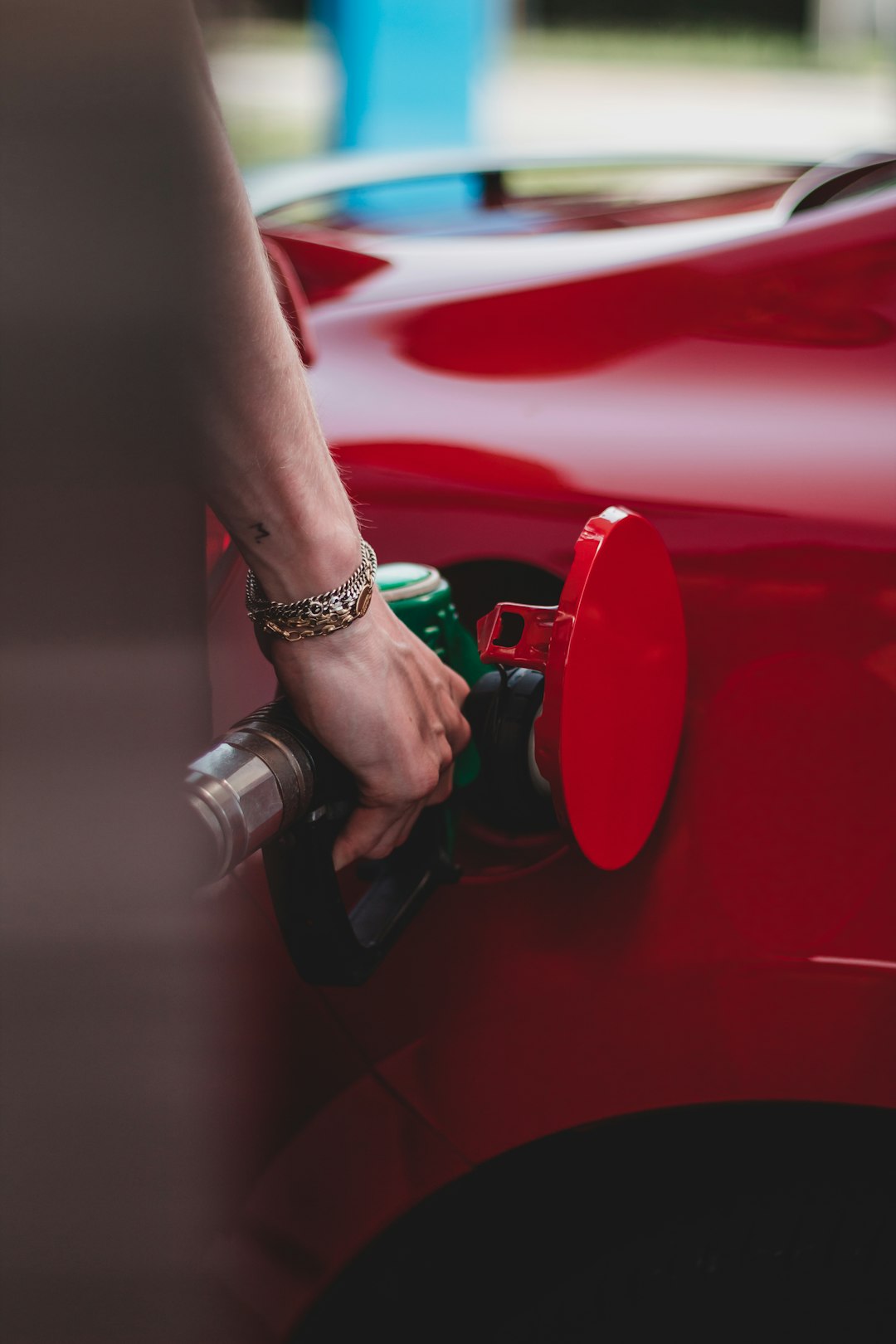We’re moving towards a greener future, and the way we travel is changing. 54 retail hydrogen fueling locations have popped up across the country by 2024. Most of them are in California, helping kick off the use of fuel cell electric vehicles (FCEVs).
These hydrogen gas stations are key for FCEVs to become more common. They provide a cleaner option compared to old fossil fuels. Growing this network is a big step towards using less fossil fuel and protecting our environment.
Key Takeaways
- The number of retail hydrogen fueling locations has reached 54 nationwide as of 2024.
- California is leading in the adoption of hydrogen gas stations.
- FCEVs offer a cleaner alternative to traditional fossil fuels.
- The expansion of hydrogen gas stations is crucial for the adoption of FCEVs.
- A sustainable transportation future is being driven by the growth of hydrogen infrastructure.
What Are Hydrogen Gas Stations?
Hydrogen gas stations are places where you can fill up hydrogen fuel cell electric vehicles (FCEVs). They are key in moving towards a hydrogen-based transport system.
These stations are crucial for a greener energy future. They support the growing number of FCEVs on the roads.
Definition and Overview
Hydrogen gas stations, also known as hydrogen fueling stations, give hydrogen fuel to vehicles. They have special tech for safe hydrogen storage and dispensing.
The process includes making, storing, and giving out hydrogen. Hydrogen can be made right there or brought to the station.
Importance in the Energy Landscape
Hydrogen gas stations are vital for a cleaner energy future. They offer fuel for FCEVs, cutting down on fossil fuel use and emissions.
| Aspect | Traditional Fuel Stations | Hydrogen Gas Stations |
|---|---|---|
| Fuel Type | Fossil Fuels (Gasoline, Diesel) | Hydrogen |
| Emissions | Contribute to Greenhouse Gas Emissions | Zero Emissions at Point of Use |
| Energy Source | Non-Renewable | Can be Produced from Renewable Sources |
As we move towards a greener energy future, hydrogen gas stations will play a bigger role.
How Do Hydrogen Gas Stations Work?
Understanding how hydrogen gas stations work is key to seeing their future role in clean energy. We’ll look at the main steps, from making hydrogen to filling up cars.
Hydrogen Production Methods
Hydrogen can be made in several ways, like steam reforming of natural gas, electrolysis of water, and gasification of biomass. Each method has its own benefits and drawbacks. The choice affects the station’s efficiency and environmental impact.
Steam reforming is the most used method. It uses high-temperature steam and natural gas to make hydrogen. But, electrolysis is getting more attention. It splits water into hydrogen and oxygen using electricity, which can come from renewable sources.
Storage and Dispensing Technology
After making hydrogen, it must be stored and dispensed at the station. It can be compressed into high-pressure tanks or liquefied at very low temperatures. The choice depends on the use and available infrastructure.
The dispensing tech at these stations is designed for safe and efficient hydrogen transfer. It manages pressure and temperature well, making refueling quick and safe for users.
As we build more hydrogen filling stations, better storage and dispensing tech will be crucial. They will help make these stations more efficient, safe, and easy to use.
Benefits of Hydrogen Fuel
As we move towards a greener energy future, hydrogen fuel’s benefits are clear. It offers many advantages, from helping the environment to boosting the economy.
Environmental Impact
Hydrogen fuel is great for the planet. It can cut down on greenhouse gas emissions. When used in cars, it only releases water vapor and heat, unlike fossil fuels.
The U.S. Department of Energy says using hydrogen could make our air cleaner. It could also help us use less carbon dioxide.
Hydrogen fuel also makes the air healthier. It can lessen air pollution, which is good for our health and the planet.
Economic Advantages
Hydrogen fuel is good for the economy too. It can create jobs in making, storing, and selling hydrogen. It also helps us use less foreign oil, which can save money.
| Economic Benefit | Description | Potential Impact |
|---|---|---|
| Job Creation | New opportunities in hydrogen production, storage, and dispensing | Stimulates local economies |
| Energy Security | Reduced dependence on imported fuels | Improves energy security and reduces price volatility impacts |
| Infrastructure Development | Investment in hydrogen infrastructure, including hydrogen station locations | Supports the growth of the hydrogen economy |
Using hydrogen fuel can help our planet and create jobs. As more hydrogen station locations are built, hydrogen’s benefits will grow.
Current State of Hydrogen Gas Stations in the U.S.
In 2024, hydrogen gas stations in the U.S. are growing fast. There are now 54 retail stations, mostly in California. This is part of a big plan to build a hydrogen fueling network across the country.
Key Statistics and Figures
The number of hydrogen gas stations shows how ready the U.S. is for fuel cell electric vehicles (FCEVs). By 2024, the U.S. has 54 operational retail hydrogen stations. This is a big step towards a network of alternative fuel stations. Plans are to add more stations in Hawaii and on the East Coast to cover more areas.
To help find these stations, tools like the Alternative Fueling Station Locator have been made. This tool helps FCEV owners find public and private hydrogen stations. It makes it easier to plan routes and refuel.
Major Regions Adopting Hydrogen Stations
California leads in hydrogen gas stations, with most of the nation’s stations. The state’s push for zero-emission vehicles has helped a lot. Other areas, like Hawaii and parts of the East Coast, are starting to add hydrogen fueling stations too.
The U.S. Department of Transportation’s Federal Highway Administration has a program to help build hydrogen stations along key roads. This program is key to placing stations where FCEV users need them.
By growing the hydrogen fueling network, the U.S. is moving towards a greener energy future. As more stations are built, they will help more FCEVs and cut down on fossil fuel use.
Comparison with Traditional Fuel Stations
Hydrogen gas stations are becoming a good choice instead of old fuel stations. They offer better efficiency, cost, and access. This shows hydrogen stations are key for a green energy future.
Efficiency and Cost
Hydrogen gas stations are getting better at refueling fast. Now, they take as long as gas stations, making them easier to use every day. Advancements in technology have made this possible, with some stations refueling in under 5 minutes.
But, hydrogen fuel is still pricier than gas. Yet, ongoing research and development aim to lower costs. As demand grows and production gets better, hydrogen will likely become cheaper.
- Key benefits of hydrogen gas stations include:
- Reduced environmental impact due to zero-emission fueling
- Increasing efficiency in refueling times
- Potential for lower costs as technology advances
User Experience and Accessibility
Hydrogen gas stations are getting better for users. They now have intuitive interfaces and easy refueling. With more stations popping up, they’re easier to find across the country.
Maps like a hydrogen fuel station map help drivers find stations. They plan their trips and enjoy smooth rides.
As we move towards a greener energy future, hydrogen stations will play a bigger part. By understanding their benefits and tackling challenges, we can create a cleaner, more efficient way to travel.
The Role of Government in Hydrogen Infrastructure
As we move towards cleaner energy, governments are key in supporting hydrogen infrastructure. They offer financial help, create rules, and invest in new tech.
Incentives for Hydrogen Adoption
Governments give out incentives to get more people using hydrogen fuel. They offer tax breaks, grants, and subsidies for those investing in hydrogen tech. For example, the U.S. Department of Energy is backing clean hydrogen hubs across the country.
Key incentives include:
- Tax credits for hydrogen production and infrastructure development
- Grants for research and development in hydrogen technology
- Subsidies for consumers purchasing hydrogen fuel cell vehicles
Regulations and Policies Supporting Development
Governments also make rules and policies to help hydrogen infrastructure grow. They set safety standards, make it easier to get permits, and support partnerships between public and private sectors.
Some governments set low-carbon fuel standards to push for hydrogen use. Others invest in hydrogen infrastructure as part of their climate plans.
| Government Initiative | Description | Impact |
|---|---|---|
| Clean Hydrogen Hubs | Development of regional hydrogen production and utilization hubs | Accelerates hydrogen adoption, creates jobs |
| Tax Credits for Hydrogen Production | Financial incentives for producing hydrogen from clean sources | Reduces production costs, encourages investment |
| Low-Carbon Fuel Standards | Regulations promoting the use of low-carbon fuels, including hydrogen | Increases demand for hydrogen, drives infrastructure development |
Worldwide, governments are pushing hard to build hydrogen infrastructure. This is key for hydrogen fuel cell tech to become common. With incentives and supportive policies, governments can help overcome early hurdles and lead to a greener energy future.

Major Players in the Hydrogen Station Market
The growth of hydrogen fueling stations is led by both big names and new startups. As we move towards a greener energy future, their roles grow more vital.
Companies Leading the Charge
Big names like Air Liquide, Air Products, and FirstElement Fuel are leading the hydrogen fuel station push. They have the money and know-how to invest in hydrogen tech. This helps them grow their networks and make their stations better.
Air Liquide is working on hydrogen projects all over the world. This makes hydrogen fuel more available and easy to get. Air Products is using its gas production and distribution skills to build a big hydrogen fuel network.
Emerging Startups and Innovations
New startups are also making waves in the hydrogen station market. They bring new ideas and focus on specific areas like cutting costs or improving dispensing tech.
Some startups are finding new ways to make hydrogen, like using renewable energy for electrolysis. Others are working on better storage and dispensing systems. This makes hydrogen fuel stations more practical and affordable.
The growth of the hydrogen fuel station network depends on teamwork between big companies and startups. They’re working together to solve problems and make hydrogen fuel a better choice for the future.
Challenges Facing Hydrogen Gas Stations
Hydrogen fuel holds great promise, but setting up hydrogen gas stations is tough. We need a lot of money for new infrastructure, to teach people about it, and to improve technology.
Infrastructure Development Hurdles
Setting up hydrogen gas stations is very expensive. It takes a lot of money for the needed equipment like electrolyzers, storage tanks, and dispensers. The cost of these parts is still too high, making it hard for businesses to make money.
Also, there’s a big problem because there’s no existing infrastructure. Without enough stations, people don’t want to buy fuel cell cars. And without many cars, companies don’t want to build more stations.
Public Perception and Awareness
Another big issue is getting people to understand and like hydrogen fuel. Many don’t know how it can help the environment or make air cleaner. Telling people about hydrogen fuel’s good points is key to get more people using FCEVs.
To help, groups like the industry, governments, and supporters are working together. They’re running campaigns, offering deals for FCEV buyers, and funding new hydrogen tech research.
By tackling these problems, we can make FCEVs more popular. This will help make our transportation system better and more green. We must keep investing in new infrastructure, spreading the word, and pushing for new hydrogen tech.
Future of Hydrogen Gas Stations
The future of hydrogen gas stations looks bright. They will help us move towards a cleaner energy world. Thanks to new tech and more money going into hydrogen, we’ll see more fueling stations.
Hydrogen refueling stations are key for hydrogen cars to become common. As we all want cleaner energy, hydrogen filling stations are more important than ever.
Predictions and Trends
Experts think we’ll see a lot more hydrogen gas stations soon. This will happen because of government help, new tech, and more people using hydrogen cars. The U.S. is set to see a big increase in hydrogen refueling infrastructure.
To learn more about hydrogen fueling stations in the U.S., check out https://www.fastechus.com/blog/hydrogen-fueling-stations-us/.
Technological Innovations on the Horizon
New tech will help hydrogen gas stations grow. Better electrolysis, storage, and dispensing tech will make things cheaper and more efficient. This will make hydrogen a better choice for everyone.

Some big tech changes include better electrolysis, advanced storage, and quicker dispensing. These will make using hydrogen easier and help the market grow.
Looking ahead, hydrogen refueling stations are crucial for our green energy future. With more money and new ideas, we’ll see more hydrogen stations all over the country.
How to Use Hydrogen Fuel Stations
Using hydrogen fuel stations is easy and safe. It’s important to know how to use them as we move towards a greener future. This knowledge helps us use hydrogen fuel cell technology smoothly.
Steps for New Users
If you’re new to hydrogen fueling, don’t worry. It’s designed to be simple. Here’s what to do:
- Find a hydrogen fuel station near you using online tools or apps that show hydrogen station locations.
- Drive up to the station and follow the instructions on the screen.
- Connect your vehicle’s fueling port to the station’s dispenser.
- Start the fueling process by paying or using a membership card.
- Wait for the fueling to finish. The station will let you know when it’s done.
Finding a hydrogen fuel station is now easier than ever. Online resources and apps help you find where to find hydrogen fuel stations. They give you up-to-date info on station locations, hours, and availability.
Safety Features and Guidelines
Safety is key at hydrogen fuel stations. They have many safety features, including:
| Safety Feature | Description |
|---|---|
| Emergency Shutdown | Automatic shutdown in case of an emergency or malfunction. |
| Leak Detection | Advanced sensors to detect any hydrogen leaks. |
| Fire Suppression | Systems designed to suppress fires in the unlikely event they occur. |
To fuel up safely, follow all on-screen instructions and guidelines. It’s also wise to know your vehicle’s hydrogen system and follow the manufacturer’s advice.
Knowing how to use hydrogen fuel stations and following safety rules helps us smoothly adopt hydrogen fuel cell technology. As more stations are built, knowing where to find them and how to fuel up will become even more crucial.
Global Examples of Successful Hydrogen Stations
Hydrogen infrastructure is growing worldwide. Countries like Japan, South Korea, and Germany are leading the way. They’re investing in hydrogen production and setting up hydrogen gas stations.
Leading Countries in Hydrogen Infrastructure
Many countries are working hard on their hydrogen infrastructure. Japan is a leader in hydrogen energy. It aims to grow its hydrogen fueling network a lot.
South Korea is also expanding its hydrogen stations fast. The government wants to make the country a top user of hydrogen energy.
Germany is important for hydrogen in Europe. It’s focusing on cutting carbon emissions. Germany has many hydrogen gas stations, mainly in big cities.
Case Studies of Effective Stations
Looking at successful hydrogen stations can teach us a lot. The network in California, USA is very advanced. It’s a good example for others.
“The growth of hydrogen fueling infrastructure is critical to supporting the adoption of fuel cell electric vehicles. Countries and regions that invest early and comprehensively in hydrogen infrastructure will be at the forefront of the transition to a cleaner transportation sector.”
The HyBalance project in Denmark shows how hydrogen can be used on a big scale. It’s a step towards cleaner energy and less emissions.
Learning from these examples can help us move towards a greener energy future. Using a hydrogen fuel station map can help find the best stations. It makes traveling with FCEVs easier.
Conclusion: Embracing a Hydrogen Future
As we look towards a greener future, hydrogen gas stations are key. They will help shape our energy world. Understanding their benefits and challenges is crucial. This way, we can all help make hydrogen fueling more common.
Key Takeaways
Hydrogen gas stations are vital for fuel cell electric vehicles to thrive. We’ve seen how hydrogen infrastructure is growing, its good points, and its hurdles. By supporting hydrogen tech and expanding fuel stations, we can cut down on fossil fuel use. This leads to a cleaner world for us all.
Supporting the Hydrogen Fuel Station Network
We need to keep pushing for more hydrogen stations. This means backing government support, investing in new tech, and teaching people about hydrogen’s perks. Together, we can build a future where hydrogen fueling is easy and green.



